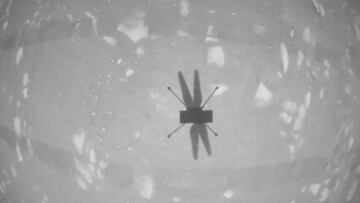What’s the mission of the mini helicopters NASA is launching to Mars?
Two small helicopters will now be part of a mission to bring samples gathered by the Perseverance rover back to Earth, it has been announced.

A joint NASA-European mission to bring rock and soil samples back from Mars will now include two small helicopters, it was announced on Wednesday.
Helicopters to help Perseverance take samples to rocket
The aircraft, which will be similar in design to the autonomous Ingenuity helicopter currently on the Red Planet, will be a backup means of carrying samples to a rocket that will lift off from Mars, NASA and European Space Agency (ESA) officials told a media briefing.
The NASA-ESA mission, known as the Mars Sample Return programme (MSR), seeks to pick up samples gathered by NASA’s Perseverance rover - which landed on Mars in February 2021 - before returning them to Earth by the early 2030s.
Perseverance, which is tasked with finding signs of ancient life on Mars, has so far collected “11 scientifically-compelling rock core samples”, NASA says.
ESA’s Sample Fetch Rover scrapped
The MSR plan had previously included an ESA-built Sample Fetch Rover as the primary means of transporting samples to NASA’s Sample Retrieval Lander. However, the reliability shown by Perseverance in its 17 months on Mars has persuaded the two space agencies that it can take on the job.
The two helicopters will be on hand in case Perseverance cannot carry out the task. “We have confidence that we can count on Perseverance to bring the samples back, and we’ve added the helicopters as a backup,” NASA’s MSR director Jeff Gramling told reporters.
Scheduled to lift off from Earth in 2028, the Sample Retrieval Lander will carry the helicopters to Mars, together with a Sample Transfer Arm and a Mars Ascent Vehicle. Designed by the ESA, the Transfer Arm will receive samples from Perseverance - or the two helicopters - and load them onto NASA’s Mars Ascent Vehicle.
In turn, the Ascent Vehicle - the first ever rocket to lift off from the planet - will transport the samples into Mars orbit, where an ESA-designed Earth Return Orbiter will be waiting to return them to Earth. Due for launch in 2027, the Return Orbiter is slated to arrive back at our home planet in 2033.
Ingenuity performance crucial to addition of helicopters
Just as the reliability shown by Perseverance has led NASA and the ESA to scrap the Sample Retrieval Lander, the success of the Ingenuity was “frankly, key” to the decision to incorporate two further helicopters into the MSR plan, NASA’s Science Mission Directorate associate administrator, Thomas Zurbuchen, said.
Since flying on Mars for the first time in April 2021, NASA’s Ingenuity has now done so 29 times - despite only being designed to complete five flights.

Helicopters capable of moving along Mars surface
Unlike Ingenuity, the new helicopters will include wheels and arms, allowing them to move across the ground and pick up sample tubes, before flying them back to the Sample Retrieval Lander.
“There’s also the possibility that we could do other things with [the helicopters],” Richard Cook of NASA’s Jet Propulsion Laboratory explained: “[They include] observing the area around the lander and potentially taking pictures of the Mars Ascent Vehicle launch when it takes off.”






